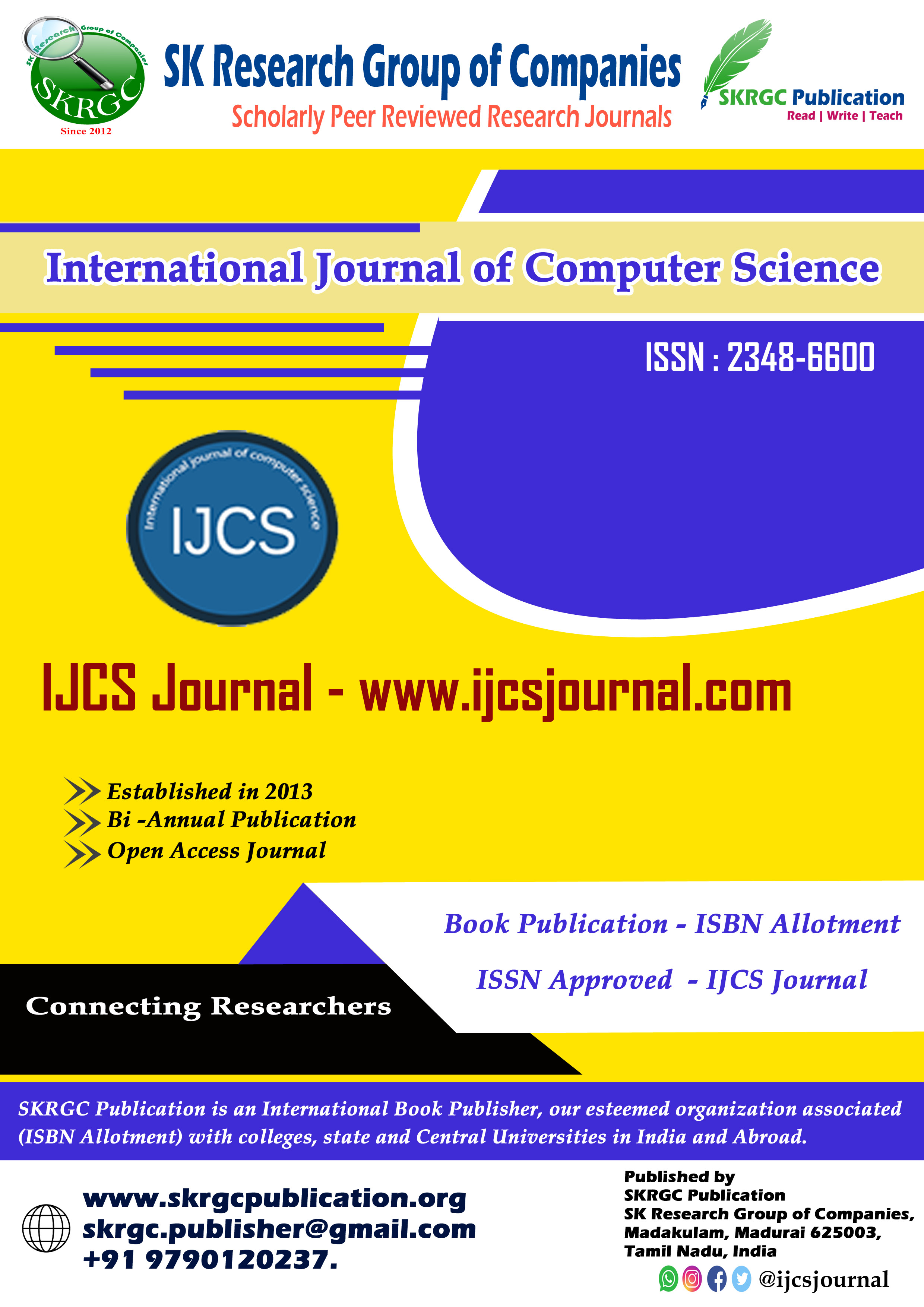E2CFTR: ENERGY-EFFICIENT CLUSTERED FAULT-TOLERANT ROUTING ALGORITHM IN INTERNET OF THINGS
International Journal of Computer Science (IJCS) Published by SK Research Group of Companies (SKRGC)
Download this PDF format
Abstract
The Internet of things which connects anything from tiny devices to large devices using Internet with the sensing equipment, in order to transfer information between devices. During this transmission, the link in IoT between devices and Base Station may fail due to temporary link breakage which is mainly due to the to the insufficient energy in the neighboring receiver IoT device and out of signal transmission range with respect to sender IoT device. As a result, the packet cannot reach its target. Devices used in hostile environments are more susceptible to faults associated with harsh environments, power outages, or hardware failure. Although it is quite evident that a non-CH faulty device will degrade the network performance, a faulty CH device can be much more problematic, as it will hamper the data dissemination process of this cluster and will make normal working devices useless. To overcome the massive energy consumption and cluster head failure issues, the proposed Energy Efficient Clustered Fault Tolerant routing algorithm schedules the sleep and awakening for all IoT devices and clusters the entire IoT network based on signal transmission range using the Cosine Distance. Hence a maximized Network lifetime with high throughput, less energy, and provides a less end-to-end delay while routing IoT data.
References
[1]. Haseeb, K., Islam, N., Almogren, A., Din, I. U., Almajed, H. N., &Guizani, N. Secret sharing-based energy-aware and multi-hop routing protocol for IoT based WSNs. IEEE Access, 7, 79980-79988, 2019.
[2]. Xin, L., Song, W., Cao, Z., & Zhang, J. Step-wise deep learning models for solving routing problems. IEEE Transactions on Industrial Informatics, 17(7), 4861-4871, 2020.
[3]. Maddikunta, P. K. R., Srivastava, G., Gadekallu, T. R., Deepa, N., &Boopathy, P. Predictive model for battery life in IoT networks. IET Intelligent Transport Systems, 14(11), 1388-1395,2020.
[4]. Julie Mary, T., &Bhuvaneshwari, A. Less Energy Consumption Routing in Internet of Things. ScopusIJRTE ,Issn 2277-3878,Volume 8, Issue 05, 2020
[5]. Julie Mary, T.,&A. Bhuvaneswari,CB-LECR: Clustering Based Less Energy Consumption Routing In Internet of Things, in International Journal of Electrical Engineering and Technology (IJEET), ISSN:0976-6545(Print);0976-6553(Online); Volume-11, Issue-9, 2020
[6]. Bounceur, A., Bezoui, M., Lagadec, L., Euler, R., Abdelkader, L., &Hammoudeh, M. Dotro: A new dominating tree routing algorithm for efficient and fault-tolerant leader election in wsns and iot networks. In International Conference on Mobile, Secure, and Programmable Networking (pp. 42-53). Springer, Cham, 2018
[7]. S. Suguna Devi &A. BhuvaneswariTrilateral Location based Maximum Weighted Directive Spanning Tree for Optimal Routing in IoV,International Journal of Computing, ISSN 2312-5381, Volume 20(4), Pp 567-574, 2021
[8].Rashid, M., Baloch, N. K., Shafique, M. A., Hussain, F., Saleem, S., Zikria, Y. B., & Yu, H.Fault-Tolerant Network-On-Chip Router Architecture Design for Heterogeneous Computing Systems in the Context of Internet of Things. Sensors, 20(18), 5355. 2020.
[9]. Sadeghi, F., &Avokh, A. Load?balanced data gathering in Internet of Things using an energy?aware cuckoo?search algorithm. International Journal of Communication Systems, 33(9), e4385, 2020
[10]. A. S. Milani and N. J. Navimipour, "Load balancing mechanisms and techniques in the cloud environments: Systematic literature review and future trends," Journal of Network and Computer Applications, vol. 71, pp. 86-98, 2016.
[11]. M. Xu, W. Tian, and R. Buyya, "A survey on load balancing algorithms for virtual machines placement incloud computing," Concurrency and Computation: Practice and Experience, vol. 29, no. 12, p. e4123, 2017.
[12] S. Suguna Devi&Bhuvaneshwari, A.“Quantile Regressive Fish Swarm Optimized Deep Convolutional Neural Learning for Reliable Data Transmission In IoV". International Journal of Computer Networks & Communications (IJCNC) Vol.13, No.2, 2021
[13]. Adil, M. “Congestion free opportunistic multipath routing load-balancing scheme for the internet of things (IoT). Computer Networks, 184, 107707. 2021
[14]. Chithaluru, P., Kumar, S., Singh, A., Benslimane, A., & Jangir, S. K. An Energy-Efficient Routing Scheduling based on Fuzzy Ranking Scheme for Internet of Things (IoT). IEEE Internet of Things Journal.2021.
[15]. R. Brendha, and V.Sinthu Janita Prakash, “Geographic Multiattribute Monarch Butterfly Optimization Based Traffic Aware Routing in VANET”, International Journal of Scientific and Technology Research (IJSTR), ISSN: 2277-8616, Vol. 08, Issue. 09, pp. 2051-2059, 2019
[16]. K. Akila, D.J.Evanjaline: “Secured IoT-WSN Architecture for Monitoring Environmental Pollution” International Journal of Scientific & Technology Research Volume 8, Issue 12, ISSN 2277-8616 pp 173 ,2019
[17]. P.Tamilselvi, T.N.Ravi “Proximity Based Hierarchical Clustering with Neighboraware Stable Link Communication for Mobile Ad Hoc Network” Annals of R.S.C.B., ISSN: 1583-6258, Vol. 25, Issue 5, PP. 4185-4192, 2021
[18]. Babu, M. V., Alzubi, J. A., Sekaran, R., Patan, R., Ramachandran, M., & Gupta, D. An improved IDAF-FIT clustering based ASLPP-RR routing with secure data aggregation in wireless sensor network. Mobile Networks and Applications, 26(3), 1059-1067, 2021.
[19]. Sampayo, S. L., Montavont, J., & Noël, TeLoBaPS: Towards energy load balancing with wake-up radios for IoT. In International Conference on Ad-Hoc Networks and Wireless (pp. 388-403). Springer, Cham, 2019
[20]. Rani, S., Kumar, A., Bagchi, A., Yadav, S., & Kumar, S. RPL Based Routing Protocols for Load Balancing in IoT Network. In Journal of Physics: Conference Series (Vol. 1950, No. 1, p. 012073). IOP Publishing, 2021
[21]. Idrees, A. K., &Witwit, A. J. Energy-efficient load-balanced RPL routing protocol for internet of things networks. International Journal of Internet Technology and Secured Transactions, 11(3), 286-306, 2021
[22]. Raj, J. S., &Basar, A. QoS optimization of energy efficient routing in IoT wireless sensor networks. Journal of ISMAC, 1(01), 12-23,2019.
[23]. Khan, I. U., Qureshi, I. M., Aziz, M. A., Cheema, T. A., & Shah, S. B. H. Smart IoT control-based nature inspired energy efficient routing protocol for flying ad hoc network (FANET). IEEE Access, 8, 56371-56378, 2020.
[24]. Debroy, S., Samanta, P., Bashir, A., & Chatterjee, M. SpEED-IoT: Spectrum aware energy efficient routing for device-to-device IoT communication. Future Generation Computer Systems, 93, 833-848,2019.
Acknowledge:The grant obtained under the Scheme of Seed Money for research projects from Cauvery College for Women (Autonomous), Tiruchirappalli-18.
Keywords
Fault Tolerant, E2CFTR Analysis, Routing, Energy Saving

